Webhook is an address for transferring data from your resource (Website, Google Ads Lead Form or any other form) to the LeadBox service, for further processing and transfer to your CRM system
Connecting the source of leads via Webhook can be configured in 3 steps:
STEP 1: Creating a Webhook in LeadBox.
- Go to the integration section
- Click “Add Integration”
- From the list of integrations that appears, select "Webhook" and click on it
- Write down the name of the integration (so that you can then understand what is which of the connected integrations)
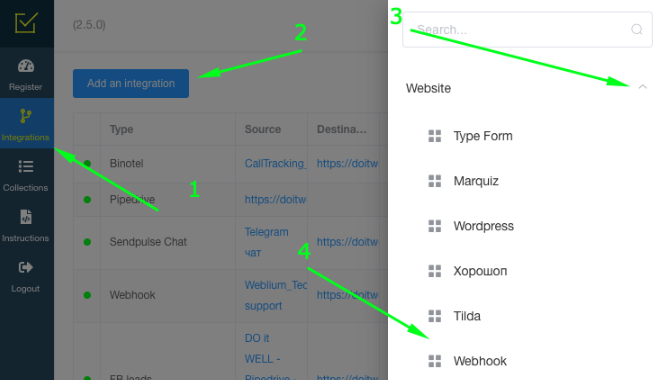
STEP 2: Set up sending data from the form of your Website or any other form to the created Webhook.
After you have saved the integration with the name, the configuration page for this integration opened. The first item after the name of the integration is the Webhook address. Copy the webhook by clicking on it.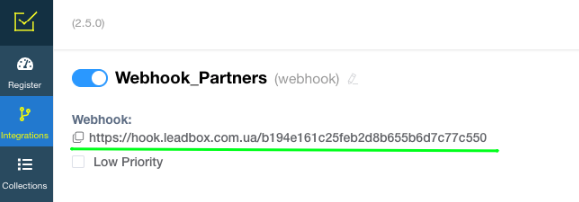
Next, you have to send data from the form (or from many forms, if they have the same structure) to this webhook.
- If your Website or form is on a service that already has a pre-configured option to send data to a webhook, you can learn how to set up this sending from the technical support of the service or from the documentation of this service.
- If your Website was developed by a technical specialist, then you need to transfer this webhook to him with a request to configure the sending of data from the form to the webhook address.
Data format: JSON
Example:
{
"name": "Ivan",
“phone”: “(099) 123-45-67”,
“email”: “test@gmail.com”
}
The response from the webhook to the server will be HTTP 200
After installing the webhook on the side of Website/form, we send a test lead. It should appear in the Register page of the LeadBox as an array of information. To expand the received data, click on the arrow in the first column of the list. You will need this data to match the fields in the next step.
To make it easier to navigate, choose JSON data display: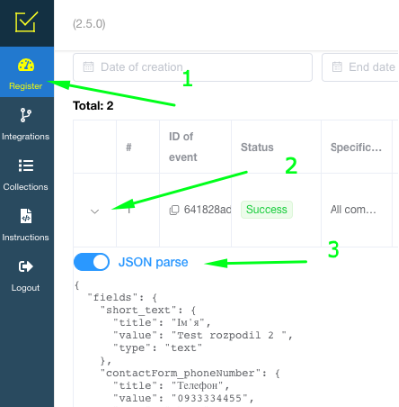
STEP 3: Setup webhook and transfer information to CRM on LeadBox side.
Open the page of webhook integration in LeadBox and go through the configuration blocks.
- Connection to - select in this field the CRM to which applications will be sent. CRM must be pre-connected
- Field mapping.
In the field mapping block, the column on the left "Parameter key" is responsible for the data that will be filled in CRM. And the column on the right "Parameter value" is for selecting data getting from Webhook.
The data put in the "Parameter value" (data received from Webhook) is taken from the first test lead that should be sent after connecting Webhook. You will find this data in the Register section of LeadBox. Depending on the fields of your form, you will receive the appropriate data set.
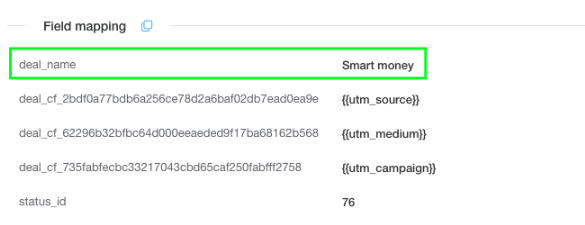
- List of responsible managers.
Settings for distribution of orders from this source among different managers. To configure, select a pre-created collection of managers. Use it if no responsible manager is configured in the field mapping block.
- Integration rules.
In the standard setting, LeadBox checks the presence of a contact and an active deal in the CRM. If there are both of them - it puts the task on the responsible user in the deal. If there is a contact only (without deal), LeadBox creates a deal assigned to the responsible manager from the existing contact. If there is neither a contact nor a deal, LeadBox will create both for the responsible user selected in the distribution settings.
This algorithm can be supplemented with settings from the blocks below:
- Disable deal creation - if activated, LeadBox will not create a deal even if there is neither a contact nor a deal in CRM. Only update data in existing deal / contact;
- Prohibit task creation for a duplicate deal - if activated, LeadBox will not create a task for the responsible user if there is a new active deal for the same contact;
- Update fields - if activated, LeadBox will update all fields in the contact and already existing active deal according to the data transferred from the new lead.
- Update only empty fields - will update only those fields that were empty in the contact / deal with new information from the lead (for example information about Traffic Source).
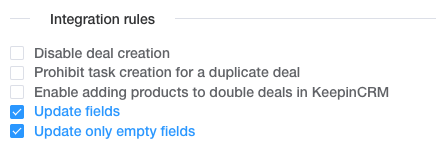
- Filter setting
Setting the filter is necessary if you do not need all the leads from this connection in your CRM system.
- Unification of the phone.
In the standardization of the phone number, the format of the Ukrainian number is a priori selected, but it is possible to insert another code and change the check of the number of characters in the phone number for leads from another country. Standardization is configured for only one format. So if you have different countries, it is better to make different lead forms for them and set the necessary number settings in each of them separately.